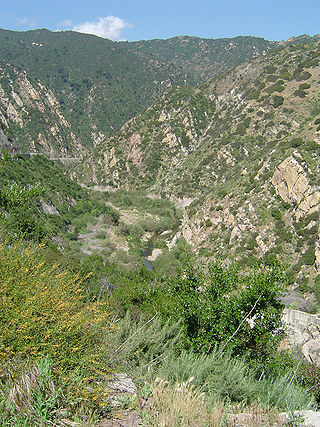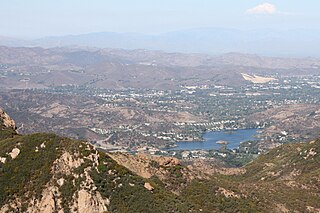Related Research Articles

Ventura County is a county located in the southern part of the U.S. state of California. As of the 2020 census, the population was 843,843. The largest city is Oxnard, and the county seat is the city of Ventura.

Camarillo is a city in Ventura County in the U.S. state of California. As of the 2020 United States Census, the population was 70,741, an increase of 5,540 from the 65,201 counted in the 2010 Census. Camarillo is named for brothers Juan and Adolfo Camarillo, prominent Californios who owned Rancho Calleguas and founded the city. California State University, Channel Islands is housed on the former grounds of the Camarillo State Hospital.

Oak Park is an unincorporated community in southeastern Ventura County, California, United States. When developed in the Simi Hills in the late 1960s, a single road provided the only access to the community from Agoura Hills, California, in neighboring Los Angeles County. As of the 2010 census, Oak Park had a population of 14,266, down from 14,625 at the 2000 census. For statistical purposes, the United States Census Bureau has defined Oak Park as a census-designated place (CDP). The census definition of the area may not precisely correspond to local understanding of the area with the same name.

The Santa Monica Mountains are a coastal mountain range in Southern California, next to the Pacific Ocean. It is part of the Transverse Ranges. The Santa Monica Mountains National Recreation Area encompasses this mountain range. Because of its proximity to densely populated regions, it is one of the most visited natural areas in California.

The Santa Clara River is an 83 mi (134 km) long river in Ventura and Los Angeles counties in Southern California. It drains parts of four ranges in the Transverse Ranges System north and northwest of Los Angeles, then flows west onto the Oxnard Plain and into the Santa Barbara Channel of the Pacific Ocean.

The Conejo Valley is a region spanning both southeastern Ventura County and northwestern Los Angeles County in Southern California, United States. It is located in the northwestern part of the Greater Los Angeles Area.
Newbury Park is a populated place in Ventura County, California, United States. Most of it lies within the western Thousand Oaks city limits, while unincorporated areas include Casa Conejo and Ventu Park. The town is located in Southern California around 8 miles (13 km) from the Pacific Ocean and has a mild year-round climate, scenic mountains, and environmental preservation. About 28,000 residents of Thousand Oaks reside in Newbury Park.

The Simi Hills are a low rocky mountain range of the Transverse Ranges in eastern Ventura County and western Los Angeles County, of southern California, United States.

Malibu Creek is a year-round stream in western Los Angeles County, California. It drains the southern Conejo Valley and Simi Hills, flowing south through the Santa Monica Mountains, and enters Santa Monica Bay in Malibu. The Malibu Creek watershed drains 109 square miles (280 km2) and its tributary creeks reach as high as 3,000 feet (910 m) into Ventura County. The creek's mainstem begins south of Westlake Village at the confluence of Triunfo Creek and Lobo Canyon Creek, and flows 13.4 miles (21.6 km) to Malibu Lagoon.

The Oxnard Plain is a large coastal plain in southwest Ventura County, California, United States surrounded by the mountains of the Transverse Ranges. The cities of Oxnard, Camarillo, Port Hueneme and much of Ventura as well as the unincorporated communities of Hollywood Beach, El Rio, Saticoy, Silver Strand Beach, and Somis lie within the over 200-square-mile alluvial plain (520 km2). The population within the plain comprises a majority of the western half of the Oxnard-Thousand Oaks-Ventura Metro Area and includes the largest city along the Central Coast of California. The 16.5-mile-long coastline (26.6 km) is among the longest stretches of continuous, linear beaches in the state.

Simi Valley is a city in the valley of the same name in the southeast region of Ventura County, California, United States. Simi Valley is 40 miles (65 km) from Downtown Los Angeles, making it part of the Greater Los Angeles Area. The city borders Thousand Oaks, Moorpark, and the Chatsworth neighborhood of Los Angeles. As of the 2020 U.S. Census the population was 126,356, up from 124,243 in 2010. The city of Simi Valley is surrounded by the Santa Susana Mountains and the Simi Hills, west of the San Fernando Valley, and northeast of the Conejo Valley. It grew as a bedroom community for the cities in the Los Angeles area and the San Fernando Valley when a freeway was built over the Santa Susana Pass.

Bell Creek is a 10-mile-long (16 km) tributary of the Los Angeles River, in the Simi Hills of Ventura County and the San Fernando Valley of Los Angeles County and City, in Southern California.

Arroyo Calabasas is a 7.0-mile-long (11.3 km) tributary of the Los Angeles River, in the southwestern San Fernando Valley area of Los Angeles County in California.
Rancho Las Posas was a 26,623-acre (107.74 km2) Mexican land grant in present-day Ventura County, California. It was given in 1834 by Governor José Figueroa to José Antonio Carrillo.
The Santa Rosa Valley is a small valley and rural unincorporated community in Ventura County, Southern California.
The Calleguas Creek Site is a 1.4-acre (0.57 ha) archeological site on Calleguas Creek and the Oxnard Plain, near Oxnard in Ventura County, Southern California.

The Arroyo Simi is a 19-mile (31 km) westwards-running creek, located in California, United States, running from the city of Simi Valley and crosses the valley from east to west, before entering the city of Moorpark. It originates at Corriganville Park by the Santa Susana Pass, travels for 12 miles (19 km) through Simi Valley, leaves the city limits of Oak Park at the western end of Simi Valley, continues for seven miles in Moorpark where it merges with Arroyo Las Posas by Hitch Road. It is a tributary to the Calleguas Creek, which enters the Pacific Ocean by its estuary at Mugu Lagoon by Naval Air Station Point Mugu. Arroyo Simi drains an area of 343 square miles in southern Ventura County. In its natural state, it is an ephemeral creek, which is only seasonally filled during winter time and periods of heavy rain. Today it is for the most part a concrete lined water drain that flows year round. Tributaries to the Arroyo Simi include the Alamos, Sycamore, Dry, Tapo, Las Llajas, White Oak, Runkle, and Bus Canyon Creeks, as well as the Erringer Road and North Simi Drains.

Arroyo Conejo carries part of the longest creek in the Conejo Valley which sprawls past the cities of Thousand Oaks and Camarillo, and the communities of Newbury Park, Casa Conejo and Santa Rosa Valley. Arroyo Conejo is the primary drainage for the City of Thousand Oaks. Its watershed covers 57 square miles (150 km2) of which 43 square miles (110 km2) are in the Conejo Valley and 14 square miles (36 km2) in the Santa Rosa Valley.

Mugu Lagoon is a salt marsh located within the Naval Base Ventura County at the foot of the Santa Monica Mountains in Ventura County, California. The lagoon extends for 4.3 miles parallel to a narrow barrier beach. The first European to come ashore here was Juan Rodríguez Cabrillo on October 10, 1542. Cabrillo was the first European to visit present-day California, and he named the lagoon Mugu after Muwu, which is Chumash meaning "beach" or "seashore". When the Europeans first discovered the lagoon, it functioned as the capital village of the Chumash Indians settled around Point Mugu.

Hill Canyon is a deep canyon in the western Simi Hills and within northern Newbury Park and Thousand Oaks, in Ventura County, southern California.
References
- ↑ Bright, William (1998). 1500 California Place Names: Their Origin and Meaning. Berkeley, CA: University of California Press.
- ↑ "Calleguas Creek". Geographic Names Information System . United States Geological Survey, United States Department of the Interior . Retrieved 16 January 2019.
- ↑ "CALLEGUAS CREEK WATERSHED". www.waterboards.ca.gov. Retrieved 31 December 2018.
- ↑ "Calleguas Creek among most polluted". Ventura County Star . July 22, 2009. Retrieved 31 December 2018.
- ↑ TALEV, MARGARET (November 16, 1999). "Calleguas Creek Study to Be Discussed". Los Angeles Times . Retrieved 31 December 2018.
- ↑ RAGLAND, JENIFER (February 25, 2002). "No Easy Way Seen to Cut Creek's Salt". Los Angeles Times . Retrieved 31 December 2018.
- ↑ "Calleguas Creek Watershed Toxicity, Chlorpyrifos and Diazinon TMDL Technical Report" (PDF). Los Angeles Regional Water Quality Control Board. April 25, 2005.
- ↑ "(PDF) Causes of toxicity in the Calleguas Creek watershed of southern California". ResearchGate. Retrieved 31 December 2018.
34°05′53″N119°05′24″W / 34.0981°N 119.0900°W